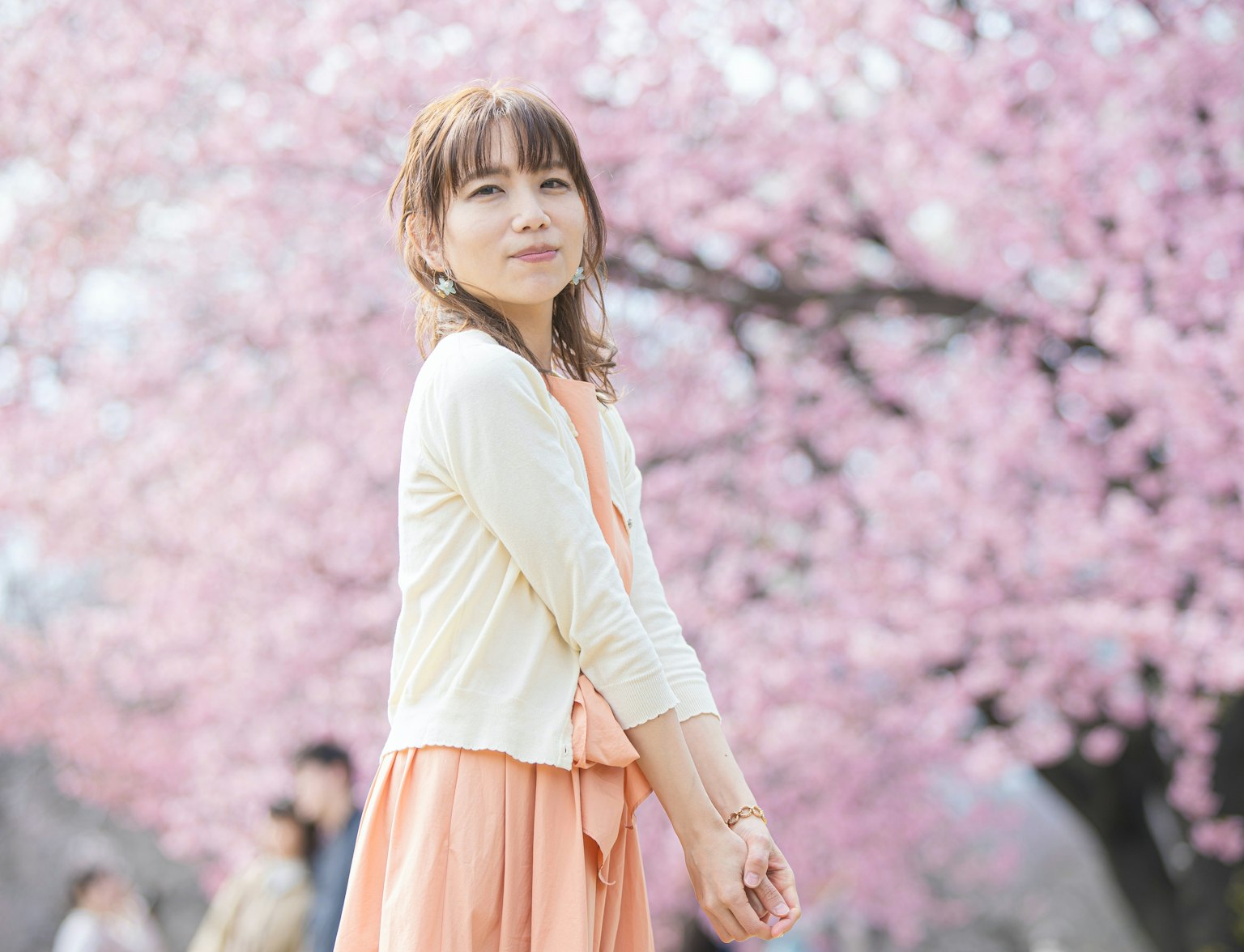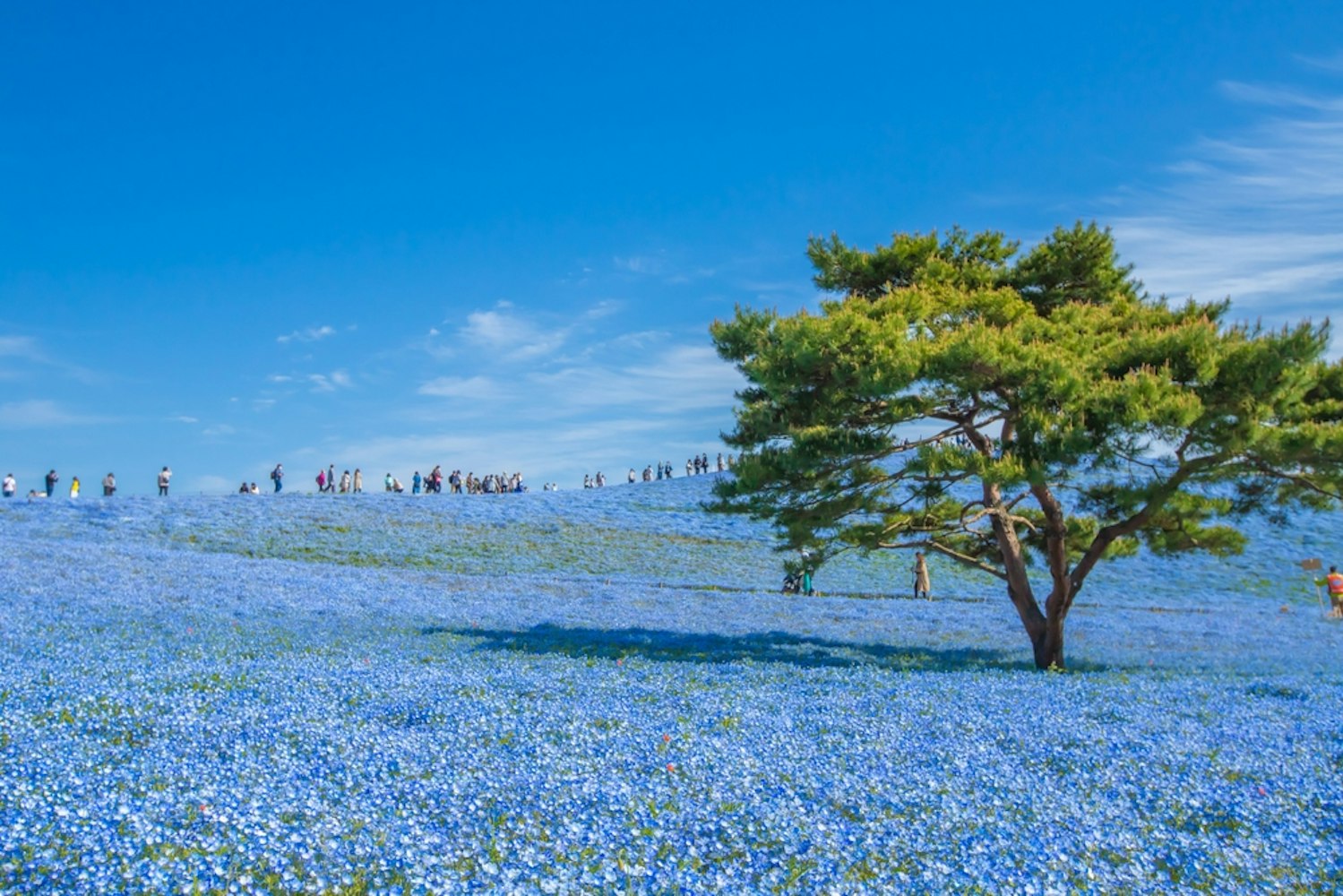

Japan's cherry blossom season is an iconic celebration that draws visitors worldwide. Known for its delicate pink sakura trees, the blossoming of cherry trees in spring marks a time of renewal and beauty in Japanese culture.
Planning the perfect trip to see these fleeting blooms requires careful timing, as the cherry blossom season is fleeting and weather-dependent. From major cities like Tokyo and Kyoto to scenic locations like Mount Yoshino and Himeji Castle, cherry blossoms in Japan are a sight.
In this guide, we'll explore the best time to visit Japan for cherry blossoms, where to go for the ultimate hanami (flower viewing) experience, and other spring blooms to enjoy during your trip.

The best time to go to Japan for cherry blossoms typically falls between late March and early April, though exact dates can vary depending on weather conditions. When the delicate flowers are at their fullest, the peak bloom of cherry blossom trees is usually in early April in central areas such as Tokyo and Kyoto.
However, late-blooming varieties in more northern regions, such as Hokkaido, extend the viewing season into late April. The season may begin in warmer areas like southern Japan from late February to early March.
The bloom period is brief, usually lasting only about a week from when the flowers open to when the petals start to fall. As such, those who want to catch Japan's cherry blossom season should plan their trip carefully around the expected bloom dates.

Ueno Park in Tokyo is among the most popular spots for cherry blossom viewing. With over 1,000 cherry trees, the park becomes a breathtaking sea of pink from late March to early April, attracting both locals and tourists who gather for traditional hanami (flower viewing) celebrations.
Alongside the cherry blossoms, visitors can explore cultural landmarks such as the Tokyo National Museum and Kiyomizu Kannondo Temple, adding a layer of history to the floral experience. The park is especially famous for its Sakura Dori, a central path where cherry trees form a striking tunnel of blossoms.
As the sun sets, the park comes alive with over 1,300 lanterns, creating a magical evening atmosphere.

Embark on a journey through Tokyo's Ueno district with this tour.

The Philosopher's Path in Kyoto is one of the city's most serene and iconic spots for cherry blossom viewing. This 2-kilometer-long stone walkway follows a tranquil canal with 450 cherry trees, offering breathtaking views during the Sakura season.
Typically, the cherry blossoms are in full bloom in early April, turning the path into a pink, flower-laden corridor that attracts visitors worldwide. The path is named after the philosopher Nishida Kitaro, known to meditate while walking along this route.
Despite being a popular destination, the Philosopher's Path retains a peaceful atmosphere, making it ideal for quiet reflection during hanami. Additionally, the path connects to several notable temples, including Ginkakuji (the Silver Pavilion) and Nanzenji, adding cultural depth to your cherry blossom experience.

Explore Kyoto’s highlights on this 4-hour private tour.

Mount Yoshino in Nara Prefecture is one of Japan's most iconic spots for cherry blossom viewing. It boasts over 30,000 cherry trees, creating a stunning pink landscape during the Sakura season.
The mountain has been a celebrated location for hanami (flower viewing) for centuries, with poems in classic Japanese anthologies like the Kokin Wakashū singing its praises. Divided into four zones—Shimo, Naka, Kami, and Oku Senbon—visitors can experience different stages of cherry blossoms as they ascend the mountain.
This tiered structure extends the viewing period, with blooms starting in the lower areas in late March and progressing upwards into early April. Mount Yoshino is part of the UNESCO World Heritage Site, "Sacred Sites and Pilgrimage Routes in the Kii Mountain Range," highlighting its profound historical and spiritual significance.

Step away from the hustle and bustle of everyday life and explore the beautiful Yoshino.

The Meguro River in Tokyo is one of the most enchanting places to witness cherry blossoms, especially during the evening. Over 800 cherry trees line the 3.8-kilometer stretch of the river, creating a breathtaking corridor of pink and white blooms during peak season in late March to early April.
At night, the scene transforms into a dreamlike spectacle, with pink lanterns softly illuminating the blossoms and casting their reflections onto the water. This evening display, known as yozakura (night cherry blossom viewing), draws crowds of locals and tourists alike for its romantic and otherworldly ambiance.
For a complete experience, stroll along the riverbanks or enjoy the blooms from one of the many cozy riverside cafés.

Visit Meguro River with your private car.

Hirosaki Castle Park in Aomori is celebrated during cherry blossom season. It features around 2,600 flowering cherry trees in over 50 varieties.
This park is particularly famous for its annual Hirosaki Cherry Blossom Festival, which occurs from late April to early May. The trees bloom against the picturesque backdrop of the historic Hirosaki Castle.
The park's cherry blossoms are known for their exceptional density, thanks to a unique pruning technique borrowed from apple tree cultivation, which encourages fuller blooms. Visitors can enjoy breathtaking views of the blossoms along the park's moat, under illuminated trees at night, and even in a tunnel of centenarian cherry trees.

Explore the wonders of Tohoku with the JR EAST PASS.
In addition to cherry blossoms, Japan is home to several other beautiful flowers that bloom during the spring. Here are four to keep an eye out for during your visit:

Plum Blossoms (Ume) is one of Japan's earliest spring flowers, typically between late February and early March, slightly earlier than the famous cherry blossoms. These delicate pink and white blooms are often celebrated in plum blossom festivals (ume matsuri) held in famous spots like Kairakuen Garden in Mito, which boasts over 3,000 plum trees of various types.
Another notable location is Kitano Tenmangu Shrine in Kyoto, where around 2,000 plum trees create a stunning display, especially during the Plum Blossom Festival on February 25. These festivals not only celebrate the beauty of the flowers but are deeply embedded in Japanese culture, marking the arrival of spring.

Wisteria (Fuji) blooms from mid-April to mid-May, creating a breathtaking display of cascading purple flowers at Ashikaga Flower Park in Tochigi Prefecture. This park, renowned for its expansive floral displays, is home to over 350 wisteria trees, including a 160-year-old "Great Wisteria" that spans an impressive 1,000 square meters.
Visitors can also experience a magical 80-meter-long tunnel of white wisteria, a designated natural monument. The park's Great Wisteria Festival, held annually during the blooming season, features illuminated displays that transform the park into a dazzling wonderland at night.

Blooms in mid to late April, azaleas bring a vivid splash of pinks, reds, and purples to various locations across Japan, most notably at Nezu Shrine in Tokyo. This shrine is renowned for its Tsutsuji Matsuri (Azalea Festival), where visitors can admire around 3,000 azalea plants in over 100 varieties.
The azalea garden, spread across a hillside, creates a breathtaking scene complemented by the shrine's traditional architecture and serene ponds. The festival typically runs from mid-April to early May, offering a vibrant alternative to the cherry blossom season.

These stunning sky-blue flowers blanket the rolling hills of Hitachi Seaside Park from mid-April to early May. About 5.3 million nemophila covers Miharashi Hill each spring, creating a breathtaking sea of blue that blends beautifully with the sky above.
The park in Ibaraki Prefecture is a must-visit destination during this season. Its serene, almost surreal landscape draws both locals and international visitors.
In addition to the flowers, visitors can enjoy themed food items such as nemophila-inspired sweets and beverages.
Here are some essential tips to make your cherry blossom trip to Japan as seamless as possible:
Check bloom forecasts: Blooming seasons vary depending on the region, so stay updated on forecasted bloom dates to plan accordingly.
Book early: Cherry blossom season is one of the busiest travel periods in Japan. Book at least six months in advance to secure accommodations, especially in popular areas.
Prepare for crowds: Major hanami spots like Ueno Park and Mount Yoshino can be crowded, especially during peak bloom. Arrive early in the morning to secure a good viewing spot.
Dress appropriately: Spring weather, with warmer days and cooler evenings, can be unpredictable. Bring layers to stay comfortable while viewing the flower.
Enjoy seasonal treats: During cherry blossom festivals, take advantage of the opportunity to try sakura mochi (sweet rice cakes wrapped in cherry leaves) and other cherry blossom-themed foods at food stalls.
Respect local customs: Hanami is deeply rooted in Japanese culture. While enjoying the flowers, be mindful of local traditions and etiquette, such as taking your trash and refraining from picking blossoms.

Welcome to the world of cherry blossom viewing in Northern Kyushu!
The beauty of Japan's cherry blossoms is more than just a spectacle—it's a celebration of nature's transient nature and a reminder of life's fleeting moments. From Ueno Park to Mount Yoshino, there are countless spots across the country where you can immerse yourself in the Sakura season and participate in the centuries-old tradition of hanami.
Whether you're witnessing the Yoshino cherry in full bloom or enjoying the serene atmosphere along the Philosopher's Path, visiting Japan during cherry blossom season offers an experience unlike any other. With careful planning, you can create the perfect trip to witness these stunning flowers and explore the rich cultural heritage that surrounds this magical time of year.



